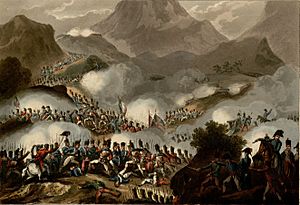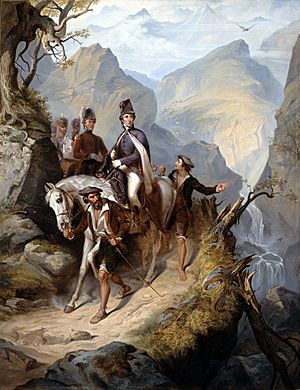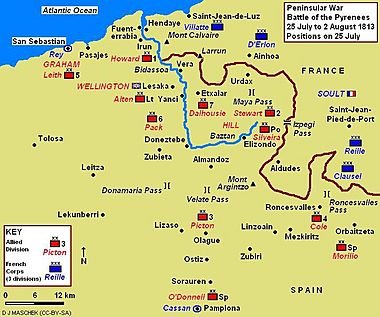Battle of the Pyrenees facts for kids
Quick facts for kids Battle of the Pyrenees |
|||||||
|---|---|---|---|---|---|---|---|
| Part of the Peninsular War | |||||||
 Battle of the Pyrenees, July 28th 1813, by Thomas Sutherland |
|||||||
|
|||||||
| Belligerents | |||||||
|
Coalition Forces
|
|||||||
| Commanders and leaders | |||||||
| Strength | |||||||
| 60,000-79,000 | 55,000-62,000 | ||||||
| Casualties and losses | |||||||
| 12,501 killed, wounded or captured | 7,000 killed, wounded or captured | ||||||
The Battle of the Pyrenees was a major military attack that took place from July 25 to August 2, 1813. It was part of the Peninsular War, a big conflict in Europe. The battle happened in the Pyrénées mountains, which form a natural border between France and Spain.
The French army, led by Marshal Jean-de-Dieu Soult, launched this attack. Their goal was to help French soldiers who were trapped and surrounded in the cities of Pamplona and San Sebastián. These cities were under siege, meaning enemy forces had them surrounded.
At first, the French had some success. But they soon faced strong resistance from the Allied forces. These Allied forces included soldiers from Britain, Portugal, and Spain, all led by Arthur Wellesley, who later became the Duke of Wellington.
After several days of fighting, Soult realized he couldn't break the sieges. He decided to retreat back to France on July 30. The Battle of the Pyrenees involved several smaller fights, like the Battle of Roncesvalles and the Battle of Maya on July 25. Later, on July 28, Wellington's troops fought off French attacks at the Battle of Sorauren. The French army suffered many more losses than the Allied army during this campaign.
Contents
What Led to the Battle?
Before this battle, the French army had suffered a big defeat at the Battle of Vitoria. After that loss, Marshal Soult gathered the remaining French soldiers, forming a large force of about 80,000 troops.
His main plan was to first free the French soldiers trapped in Pamplona. After that, he wanted to move his army west to help the soldiers stuck in San Sebastián. To do this, he ordered his generals to attack and secure important mountain passes.
General d'Erlon was to attack the Maya Pass with 21,000 men. Generals Reille and Clausel were ordered to attack the Roncesvalles Pass with about 40,000 men. These passes were key entry points into Spain through the mountains.
Who Fought in the Battle?
The French army, led by Marshal Soult, had a total of about 99,906 soldiers. However, only about 63,572 of them were directly involved in the main attack. These soldiers were organized into different groups, called corps and divisions.
The Allied forces, led by Wellington, had about 62,000 soldiers. These included British, Portuguese, and Spanish troops. They were spread out along the mountain passes to defend against a French attack.
Wellington's army was positioned to protect the important cities and passes. For example, the British 2nd Division was at the Maya Pass, and the British 4th Division and a Spanish division were at the Roncesvalles Pass. Other divisions were kept in reserve, ready to move where needed.
Two important cities, San Sebastián and Pamplona, were under siege. British and Spanish forces were trying to capture them. The French attack was an attempt to break these sieges.
Key Moments of the Battle
The French surprise attack began on July 25, 1813. The Maya and Roncesvalles passes were not strongly defended, as the Allied forces were spread out.
Fighting at Maya and Roncesvalles Passes
At the Maya Pass, the British 2nd Division was responsible for defense. On the morning of July 25, the French attacked with a large force. The British soldiers had to quickly climb to the pass while carrying all their gear. The French managed to take the pass.
In the Battle of Maya, about 4,000 British soldiers bravely tried to take back the pass from 20,900 French troops. They couldn't recapture it, but the narrow mountain pass helped them hold off the much larger French force. Later, more British troops arrived, and the fighting lessened. The British lost 1,610 men, while the French lost 2,100. The British then retreated.
At the Roncesvalles Pass, the British 4th Division and a Spanish division, about 11,000 men, faced a French attack. In the Battle of Roncesvalles, they fought hard for hours. The Allies lost 350 men, and the French lost about 530. Due to thick fog and fears of being overwhelmed, the Allied commander decided to retreat towards Pamplona, even though he was ordered to hold the pass.
The French didn't realize the Allies had left until the next morning because of the fog. They pursued the retreating Allied forces. Meanwhile, Wellington, who had been focused on the Maya Pass, rode to Pamplona to understand what was happening. He ordered more troops to join the forces near Pamplona.
Sorauren and the French Retreat
On July 27, Wellington joined about 17,000 British and Portuguese soldiers at a strong defensive position near the village of Sorauren, just north of Pamplona.
The next day, July 28, in the Battle of Sorauren, Soult's 36,000 French soldiers attacked Wellington's 24,000 Allied troops. The French attacks were unsuccessful. The Allies lost 2,652 soldiers, while the French likely lost even more.
Instead of retreating back the way he came, Soult decided to move north. On July 30, Wellington attacked the French as they were retreating. The French fought hard in Sorauren village but were eventually pushed back. Some French troops retreated northeast, but most of the French army, led by d'Erlon, continued retreating north.
Soult chose to retreat up the Bidassoa River valley instead of using the Maya Pass. At a place called Yanci, a small Spanish force bravely held a key bridge for two hours against a much larger French force. This slowed the French down.
As the French army continued to retreat, it became disorganized. Many soldiers were starving. On August 2, the French reached the border and crossed back into France. They fought a final small battle at Etxalar as their rearguard tried to hold off the pursuing Allies. The French lost about 300 men, and the Allies lost 368. Over 1,000 wounded French soldiers were left behind and captured.
What Was the Outcome?
Marshal Soult's plan to rescue the French garrisons at San Sebastián and Pamplona failed. The French army suffered heavy losses, with about 13,000 soldiers killed, wounded, or captured. This included 1,313 killed, 8,582 wounded, and 2,702 captured. Many French officers were also among the casualties.
In comparison, Wellington's Allied army lost about 7,000 soldiers during the entire campaign. The French army was weakened and morale was low after this defeat. The next major battle in the region was the Battle of San Marcial at the end of August.




